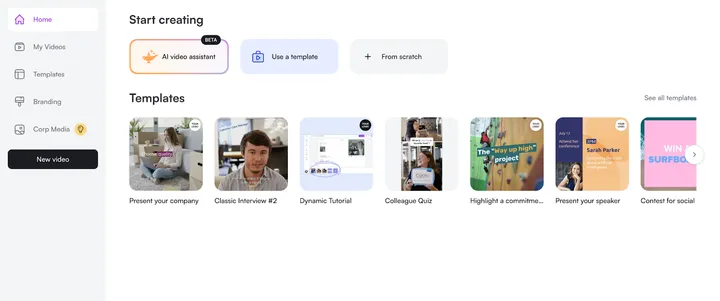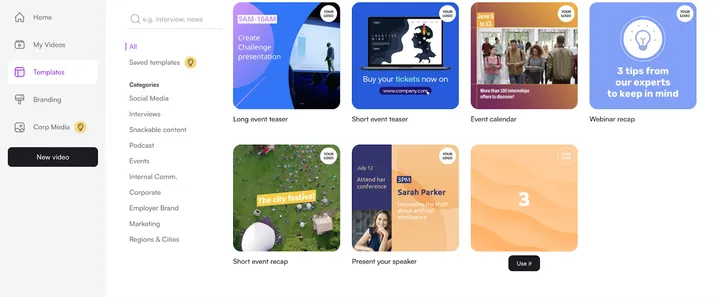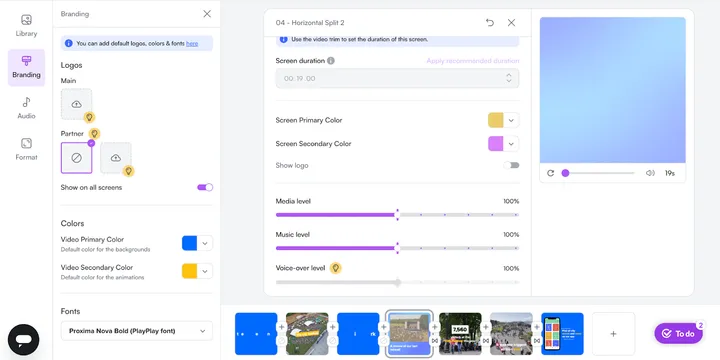To succeed in the competitive market space, you need a cost-effective yet potent marketing strategy that consistently puts you in front of your target audience, piques their interest, and eventually translates into market share.
That’s what brand awareness content is for.
In this article, we’ll showcase 8 of our favorite brand awareness video examples to help you gain some inspiration for your next marketing campaign. We’ll also explain why this type of video is a crucial action for gaining more audience attention and strengthening your business strategy.
8 best brand awareness video examples for your company
Now that you know how to level up your branding efforts with video, let’s get into these 5 brand awareness video examples!
1. Employer branding
Industry: Technology
Video length: 6 minutes 48 seconds
Employer branding videos position your company as a great place to work and help you attract A+ talent. But they are also a powerful tool for raising brand awareness — even when you aren't recruiting.
You can use employer branding videos to showcase your visual elements repeatedly for brand recognition. PlayPlay’s quarterly recap videos, for example, always include our logo, brand name, colors, and even product references to make it easy for our audience (and anyone really) to recognize and remember us.
Employer branding videos are also pretty valuable for rebranding campaigns, which is when a brand introduces a new name, style, or tagline to the market. In this case, we talk about brand launch videos here.
Why it works:
- It clearly explains why the company changed its name and introduces its new logo and vision to its audience.
- It helped Meta’s audience adjust to the brand change in no time!
- The interesting choice of not adding music makes you focus on the words of the high-profile CEO, and choosing to have him do this announcement is also a tactic for getting views and attention for this announcement.

Attract, retain and maximize ROI with employer branding
In this article, you will find everything you need for creating a strong employer brand strategy that guarantees ROI.
2. User-generated content (UGC)
Industry: Food
Video length: 1 minute
User-generated videos are the ones your audience is creating and sharing about your brand. In other words, they tell your brand’s story from the their own point of view.
Whatever the case, UGC puts your brand in front of a new audience. Say a creator with 10,000 followers shares a video about your brand; that's potentially 10,000 new viewers learning about you. They might become customers or recommend your product or services to others in their network.
Authenticity is key if you partner with influencers for UGC video production. Remember, viewers want to see the creator’s first-hand experience with your brand, not a salesy promotional video. If you don't have the budget for influencer partnerships, you can:
- Create a branded hashtag and be encouraging for your customers to share UGC with it. For example, Wayfair asks customers to share pictures of their purchases with #wayfairfinds.
- Organize a UGC video competition or giveaway like the GinoMax Christmas Challenge.
Why it works:
- It features a client using one of the company’s products with their branding and hashtags.
- It’s a great method of showing off different ways you can use the product to experience all the benefits!
- It’s fun, bright, and has an energetic delivery from the influencer chosen! This call out for UGC will expand the brand’s reach, especially since they started with using a well-known, bubbly individual.
3. Product presentations
Industry: Video Creation
Video length: 2 minutes
Product videos highlight the features and benefits of your products. A good example is this video production introducing PlayPlay’s AI Video Assistant. It's a two-minute walkthrough video where our CEO explains how the new product fits into PlayPlay's vision before doing a quick demo to show how it works.
A business can use product videos as sales and customer success collateral for attracting and retaining customers. But, when they aren't generating sales leads or expanding customer accounts, they can increase your brand's share of voice. Share of voice is the number of viewers who know and talk about your brand.
Let's say you share a video tutorial on how your products or services solve a particular problem. A viewer searching for that solution might watch the tutorial and learn about your brand. This viewer might sign up for your products or services immediately, but those who are not ready to buy have now at least discovered your brand. They can help you spread the word by sharing the video production with their audience or mentioning your brand in industry conversations.
If you share your videos on social media platforms like LinkedIn and YouTube, their algorithms can amplify them, helping you reach more users.
Why it works:
- It was shared on multiple social media platforms to increase visibility and engagement.
- It explains a new feature so that any viewer becomes more knowledgeable about all the exciting announcements your company has!
- It gets folks familiar with what your brand is all about (and what it’s trying to solve!)

Want to explore further into branded product video creation?
4. Vlogs
Industry: Technology
Video length: 1 minute 37 seconds
A vlog is a narrative video production documenting the creator's authentic experiences. It is particularly effective for brand awareness because it piggybacks on your employees’ influence and online following to help you reach new viewers.
For example, an employee who takes over your brand's social account for a day will likely ask viewers in their own network to tune in. Individuals typically have additional social media following outside of the brand they work at (meaning they people who follow them are likely not the same people who follow the brand) — it’s a creative way to reach a wider audience.
So, what type of vlogs should you be creating? “A Day in My Life video” is the first choice for most brands because it showcases the company culture in an authentic and exciting way.
Employees can record the video, so the company uploads it to their social media accounts — like Oktopost does. Or the employee can take over your social accounts for a specific period of time (like we mentioned earlier) to share their experiences with their target audience in real-time. Kuno Creative, for example, let employees take over its Instagram account and gained 450 followers in three months.
Why it works:
- It features employees that give their target audience a creative, unfiltered look at their typical workday — from preparing for work to tasks and meetings at the office.
- It also features employees’ after-work routines to humanize the company and place importance on what employees do when they leave the office!
- It’s fun, authentic content that doesn’t try to actively sell. Today with all the noise online, people don’t want to always be sold to (or feel like they are!).
5. Event promotions
Industry: Video Creation
Video length: 22 seconds
Event teasers and promotion videos are a creative way to raise brand awareness because they are widely distributed.
When you post these creative videos to your social channels, ask prospective event attendees, speakers, and your employees to amplify them. If they like and comment on the posts, you’ll boost your company visibility. Some might repost them on their feed or use them for creating new content.
PlayPlay's Content Summit is a great example here. We shared a promotional video on our brand accounts to create excitement for our online all-day event. Attendees, speakers, and our employees created new content with these videos and shared them on their personal pages too.
Why it works:
- It was easily shareable by the event attendees, which helped us reach a wider audience.
- It shared interesting topics that would appeal to a large audience and further increase brand awareness.
- The music and graphics are fun, and the video is short and sweet, making it extra shareable.
6. Emotional storytelling
Industry: Beauty
Video length: 3 minutes
Emotional storytelling in brand videos helps connect with any public on a deeper level, making the brand feel more authentic. When a story evokes emotions like joy, nostalgia, or empathy, it is more likely to grab attention and make viewers want to engage with the post and share it on their social platforms. That emotional connection sticks with people, building trust and loyalty over time.
Why it works:
- It highlights self-perception vs. reality by having an artist draw women based on their descriptions vs. those of strangers, which is a touching message about self-esteem and beauty.
- The participants are vulnerable and deeply share how they feel. This feels very honest and with good intentions.
- It reflects Dove’s commitment to boosting self-confidence and challenging beauty standards, staying true to the brand’s core values.
7. Inclusive storytelling
Industry: Sportswear
Video length: 1 minute
Another way to promote your brand’s culture is to create a video that aligns with a diverse public. This inclusivity reaches a far wider audience by tapping into audience members’ differences and showing why the brand can be great for all!
This ad is a great example of a brand awareness campaign because it clearly showcases the brand’s core values of resilience, unity, and empowerment through sport. It seamlessly aligns with Nike’s identity, motivating viewers to push their limits while reinforcing powerful messaging.
Why it works:
- It uses creative visuals with a split-screen technique, which captivates its viewers in a unique way. It gives you a lot to look at at all times.
- It emphasizes perseverance and unity, which resonates with individuals who seek motivation and strength.
- It features athletes from a wide variety of backgrounds. It’s inspiring and can leave the viewers feeling positive emotions.
8. Artistic productions
Industry: Technology
Video length: 4 minutes 46 seconds
This Apple ad tells a visually stunning story with surreal choreography and a powerful soundtrack. The HomePod isn’t just shown off — it takes center stage, showcasing its ability to transform the space and mood. It beautifully captures Apple’s goal of blending innovation with creativity, making technology feel personal and emotionally impactful.
Why it works:
- It uses artistic visual elements to keep viewers engaged and create a memorable viewing experience for them.
- It leans on emotional connection to evoke feelings of joy and excitement with its audience, reinforcing Apple’s mission of blending technology with personal experience.
- The creativity and lean towards artistry are things that the general public appreciates and enjoys consuming, giving Apple credit for promoting true art along with its own brand.
What is brand awareness?
Brand awareness is how well people, especially your target audience, recognize and remember your brand.
It starts with the obvious things like how easily they identify your logo, colors, product packaging, brand name, and other visuals — but it doesn’t end there.
Some brands get so popular that they become household names for entire product categories — this is called brand genericization. A good example is how people use “Google” to refer to every and anything search and “Band-Aid” for adhesive bandages.
It certainly takes time to reach this level of awareness, but incorporating video into your branding strategy can help you achieve this goal faster by providing better visuals for your target audience.
Why create brand awareness videos?
About 95% of marketers in Wyzowl’s 2023 State of Video Marketing report said that videos have helped them increase brand awareness. Video works well for brand awareness because:
- It’s easy to share: Video is the most shareable type of online content. More than 50% of people who watch a video they enjoy will likely share it with someone in their network — making it the most effective way to get your brand in front of new people.
- It’s memorable: People are more likely to recall visual information — like images and colors — than text alone.
- It’s engaging: Video conveys information, emotions, and brand messages through a combination of visuals, audio and text — engaging multiple senses simultaneously.
How to increase brand awareness with video
Driving brand awareness and attention with video doesn’t happen by chance. You need to intentionally bake brand visibility elements into your brand content to stand out and attract the right attention.
1. Use consistent visual elements repeatedly
Visual elements — like your logo and color schemes — are the easiest way for people to identify and remember your brand book.
For these visuals to stick in your target audience’s mind, you need two things for your campaign:
- Consistency: Use brand guidelines to ensure that your logo, colors, and other visual elements are presented in the same way every time.
- Repetition: Always use brand visual elements. The more frequently people see them, the easier it gets to identify and associate these elements with your brand. Per the rule of seven, your target audience needs to see your visual elements at least seven times to recall them!
“But I’m publishing a ton of videos! Customizing each one will slow me down.”
Yes. That’s why you need to automate the process. PlayPlay, for example, lets you create branded video templates with your logo, colors, fonts and everything else matching your unique style. Simply use the templates to customize and publish new videos quickly.
2. Limit “salesy-ness”
Nearly 90% of respondents in an ORC survey said they skip online video ad campaigns. This is because they are too obvious in trying to sell a product, which deters viewers from watching the ads.
This doesn’t mean you shouldn’t talk about your products in your marketing campaign. You can and should: “86% of people say watching a video has convinced them to buy a new product.”
So what gives? Your campaign should prioritize audience education to increase sales. Creating exciting videos that deliver the message of how your products solve specific problems is crucial for educating prospects about your brand. This is how you pique their interest with your message and convert them into buying customers.
3. Tell compelling stories
Brand storytelling is how you build deep and lasting connections with any viewer from your target audience. Your videos should build on viewer emotions through a compelling message — whether it's humor, empathy, inspiration, or excitement — and reinforce your brand’s goals, mission, and values.
For example, much of the success of Coca-Cola’s “Share-a-Coke” campaign resulted from compelling storytelling. Through nostalgic feel-good narratives, the campaign showed people how sharing a Coke can help them connect with friends and family and create special shared moments.
A compelling story or message must go hand in hand with a great use of visual elements in your campaign. Check out these examples of best brand videos to inspire you into making yours!
4. Distribute on the right channels
Don’t call it a day after publishing your video on one platform. Instead, reshare it on other platforms where a typical viewer from your target audience hangs out.
Tailor your branded video content to fit the platform where you plan to share it. For example, bite-sized clips do well on Instagram and TikTok, while YouTube prefers longer, in-depth ones.
Say you posted a vlog on YouTube; break it up into smaller clips and publish them on LinkedIn, TikTok, and X (Twitter). That’s how you’ll get more visibility and encourage users to take action such as liking, commenting, or sharing your post.
5. Encourage engagement
Social media platforms reward engagement. The TikTok algorithm, for instance, uses engagement rates to measure post quality and boost reach. So, the more viewers like, share, and comment, the more views you get.
If you want a viewer to engage with your posts, engage with theirs first. They’ll more likely return the favor (that’s why community building today is so key for brands)! Also, ask clear questions, run contests, or provide incentives along with producing engaging visuals to get your target audience’s attention and encourage them to be more involved with your brand.
How to create brand awareness videos with PlayPlay
PlayPlay is a video maker lets you create engaging and professional brand awareness videos in less than 10 minutes. This tutorial assumes that you’ve already recorded your video.
Let’s dig in:
Step 1: Sign up for a free PlayPlay account.
Step 2: Select how you want to create the video. You can choose a template, try the AI video assistant, or do it from scratch. For this tutorial, we'll use a template.
Step 3: Choose your preferred template. We’ll use the short event recap template. Selecting the template takes you to the video editor.
Step 4: Click “upload media” to import your recorded video into your project dashboard.
Step 5: Edit the video elements. You can change text and color, add new screens, crop your video, and insert clips into different parts of the template. For example, we changed the template’s primary colors.
Step 6: Add your brand elements like logo, color, and typography to the video. You can save and use them repeatedly.
Step 7: Click “Preview” at the top right corner of your screen to see what your video looks like.
Step 8: If you’re satisfied with the look and feel, click “Generate HD video” at the bottom right corner of your screen to create a high-definition quality video. This will take a few minutes.
Step 9: That’s it! Your video is ready. Share it with your team for review, use the share link to share it with your audience, or download and upload it to your communication channels in a few clicks.
How to measure brand awareness video success
Even though it’s hard to measure brand awareness because it’s intangible, there are two popular techniques to give you a sense of your brand visibility levels.
1. Performance metrics
The first technique is to track your videos’ performance metrics when viewers take action: shares, number of views, and likes. This method is your best bet at gauging your brand reach and visibility!
For example, a consistent increase in post engagements shows that your videos reach and resonate with a wider audience. These metrics will show up in the social platform's analytics and will better position you.
2. Social mentions
Another way to gauge your brand reach and visibility levels during your campaign is to track your company’s social mentions with tools like Brandwatch.
If more people are taking action by talking positively about your brand online, then you’ve done something right.
Ready to scale your brand awareness with video?
Now that you know how effective videos are for brand awareness, it’s time to try things out for yourself. And the best part is you don’t need any technical skills to pull this off. You can create and launch an exciting brand introduction video in minutes with PlayPlay.
With our wide range of templates and drag-and-drop features, it's never been easier to create professional-looking videos. Try it today and start scaling your brand!
Try PlayPlay for free!
Here are 5 types of brand awareness campaigns that will help you achieve your business goals:
- Social media campaigns
- User-generated content campaigns
- Event marketing campaigns
- Partnership campaigns
- Rebranding campaigns
A brand video is great for your business because it achieves the following goals: enhancing awareness, conveying core values, and building customer loyalty. An effective brand video meets these goals by incorporating a clear objective, a compelling story, and clear, dynamic visuals.
If you’re a marketing professional who wants to build a brand, you should follow these four steps to achieve your campaign goals:
- Identify your target audience.
- Position your business in the market.
- Define your company identity.
- Create a unique logo and slogan for your business.
Melissa Francois
Head of Global Content & Comms
With over 10 years of experience in the wild world of SaaS, Melissa cares about building great brand stories and driving community engagement through engaging content. Off the clock, she enjoys long walks and a pint in a cozy country pub.






